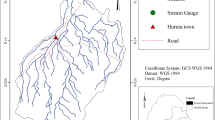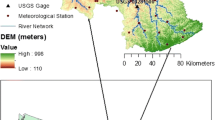Abstract
Climate change could have impacts on hydrologic systems threatening, availability of water supply resources. In Illinois, regional water supply planning efforts are attempting to better understand potential impacts on low flow and surface water availability through analysis of hydrologic sensitivity to a range of climate scenarios. This paper explores the development, calibration and validation of Fox River watershed model using the soil and water assessment tool (SWAT) and the model’s application to assess impacts of potential climate change. The watershed model is calibrated and validated using daily flow records at three gauging stations. Automatic model calibration followed by manual refinement of parameter values was performed. Calibration results were generally good for monthly and annual time step but only satisfactory for daily simulations. Based on simulations of global climate models produced for IPCC fourth assessment report, climate scenarios were prepared by the Illinois State Water Survey for water supply planning initiatives in north-east and east-central Illinois. These scenarios showed ranges of temperature change between 0°C to +3.3°C and annual precipitation changes between −127 to +127 mm in the next 50 years, excluding the 5% extreme ends of those climate model simulations considered. Changes in climate were reflected using adjustments to the historical record, instead of using direct outputs from individual climate models. The watershed model was used to assess the impact of potential climate change. Application results indicate that annual precipitation change of 127 mm on average increases annual water yield and 7-day low flows by 28% and 19%, respectively. In contrast, a temperature change of +3.3°C results in average reductions of annual water yield by 13% and 7-day low flows by 10%. Seasonal effects were investigated through evaluation of changes in average monthly flows. Increasing precipitation resulted in significant changes in streamflows in late summer and fall months where as increasing temperature greatly affects winter flows due to snowmelt. The key implication is that climate change-induced variability of streamflows could have major impacts on water supply availability in the Fox River watershed and in particular, increased periods of drought could result in deficit of supplies during seasons of peak water use. It must be noted that this analysis does not examine the potential impacts of population growth and water use on water supply availability, which are also expected to have substantial influences in the region.
Similar content being viewed by others
Explore related subjects
Discover the latest articles and news from researchers in related subjects, suggested using machine learning.References
Abbaspour KC, Jing Y, Ivan M, Rosi S, Konrad B, Johanna M, Juerg Z, Raghavan S (2007) Modeling hydrology and water quality in the pre-alpine/alpine Thur watershed using SWAT. J Hydrol 333(2–4):413–430
Arnold JG, Allen PM (1999) Automated methods for estimating baseflow and groundwater recharge from streamflow records. J Am Water Resour Assoc 35(2):411–424
Arnold JG, Williams JR, Srinivasan R, King KW (1999) SWAT: soil and water assessment tool. USDA, Agricultural Research Service, Temple
Bekele EG, Nicklow JW (2007) Multi-objective automatic calibration of SWAT using NSGA-II. J Hydrol 341:165–176
Cao W, William BB, Tim D, Andrew F (2009) Modeling impacts of land cover change on critical water resources in the Motueka River catchment, New Zealand. Water Resour Manag 23(1):137–151
Chang H, Evans B, Easterling D (2001) Effects of climate change on streamflow and nutrient loading. J Am Water Resourc Assoc 37(4):973–986
Choi W (2008) Catchment-scale hydrological response to climate–land-use combined scenarios: a case study for the Kishwaukee River Basin, Illinois. Phys Geogr 29:79–99
Di Luzio M, Srinivasan R, Arnold JG, Neitsch SL (2002) Arcview interface for SWAT2000- users’ guide. Blackland Research Center, Texas Agricultural Experiment Station, Temple
Diaz-Nieto J, Robert LW (2005) A comparison of statistical downscaling and climate change factor methods: impacts on low flows in the River Thames, United Kingdom. Clim Change 69:245–268
Ficklin DL, Yuzhou L, Eike L, Minghua Z (2009) Climate change sensitivity assessment of a highly agricultural watershed using SWAT. J Hydrol 374:16–29
Franczyk J, Heejun C (2009) The effects of climate change and urbanization on the runoff of the Rock Creek basin in the Portland metropolitan area, Oregon, USA. Hydrol Process 23:805–815
Gassman PW, Reyes MR, Green CH, Arnold JG (2007) The soil and water assessment tool: historical development, applications, and future research directions. Trans ASABE 50(4):1211–12850
Goldberg DE (1989) Genetic algorithms in search, optimization and machine learning. Addison-Wesley Publishing Co., Reading
Gupta HV, Sorooshian S, Yapo PO (1999) Status of automatic calibration for hydrologic models: comparison with multilevel expert calibration. J Hydrol Eng 4(2):135–143
Holland JH (1975) Adaptation in natural and artificial systems. Univ Michigan Press, Ann Arbor
Immerzeel WW, Droogers P (2008) Calibration of a distributed hydrological model based on satellite evapotranspiration. J Hydrol 349(3–4):411–424
IPCC AR4 (2007) Climate change—the physical science basis of climate change. Available http://ipcc-wg1.ucar.edu/wg1/Report/AR4WG1_Print_TS.pdf. Accessed 10 Jan 2009
ISWS (2008a) Illinois water supply planning—climate factors in water supply planning. Available http://www.isws.illinois.edu/wsp/climate.asp. Accessed 15 Mar 2008
ISWS (2008b) Illinois water supply planning—climate factors in water supply planning. Available http://www.isws.illinois.edu/wsp/waterdemand.asp. Accessed 15 Dec 2009
Jha M, Jeffrey GA, Phillip WG, Flippo G, Roy RG (2007) Climate change assessment on Upper Mississippi River Basin streamflows using SWAT. J Am Water Resour Assoc 42(4):997–1015
Knapp HV, Ortel TW (1992) Effect of stratton dam operation on flood control along the Fox River and Fox chain of lakes. Rep. No. 533, Illinois State Water Survey, Champaign, IL
Maringanti C, Indrajeet C, Jennie P (2009) Development of a multiobjective optimization tool for the selection and placement of best management practices for nonpoint source pollution control. Water Resour Res 45:W06406. doi:10.1029/2008WR007094
Marshall E, Randhir T (2008) Effects of climate change on watershed system: a regional analysis. Clim Change 89:263–280
Mingna W, Qin D, Lu C, Li Y (2010) Modeling anthropogenic impacts and hydrological processes on a wetland in China. Water Resour Manag. doi:10.1007/s11269-010-9577-0
Moriasi DN, Arnold JG, Van Liew MW, Binger RL, Harmel RD, Veith TL (2007) Model evaluation guidelines for systematic quantification of accuracy in watershed simulations. Trans ASABE 50(3):885–900
Nash JE, Sutcliffe JV (1970) River flow forecasting through conceptual models: part I—a discussion of principles. J Hydrol 125:277–291
Neitsch SL, Arnold JG, Kiniry JR, Williams JR (2001) Soil and water assessment tool theoretical documentation version 2000. Grassland, Soil and Water Research Service, Temple
Stone M, Hotchkiss R, Hubbard C, Fontaine T, Mearns L, Arnold J (2001) Impacts of climate change on Missouri River basin water yield. J Am Water Resour Assoc 37(5):1119–1128
Tolson BA, Shoemaker CA (2007) Cannonsville Watershed SWAT2000 model development, calibration and validation. J Hydrol 337:68–86
USEPA (2007) USEPA’s BASINS data website. Available at: http://www.epa.gov/waterscience/ftp/basins/gis_data/huc/. Accessed 20 Feb 2007
USEPA (2009) Climate change. Available at http://www.epa.gov/climatechange. Accessed 5 Jan 2009
Van Griensven A, Bauwens W (2003) Multiobjective autocalibration for semi-distributed water quality models. Water Resour Res 39(12):1348
Winstanley D, Angel JA, Changnon SA, Knapp HV, Kunkel KE, Palecki MA, Scott RW, Wehrmann HA (2006) The water cycle and water budgets in Illinois: a framework for drought and water supply planning. Illinois State Water Survey, Champaign
Yang YS, Wang L (2009) Review of modeling tools for implementation of the EU Water Framework Directive in handling diffuse water pollution. Water Resour Manag. doi:10.1007/s11269-009-9526-y
Zhang Y, Jun X, Tao L, Quanxi S (2009) Impact of water projects on river flow regimes and water quality in Huai River basin. Water Resour Manag. doi:10.1007/s11269-009-9477-3
Author information
Authors and Affiliations
Corresponding author
Rights and permissions
About this article
Cite this article
Bekele, E.G., Knapp, H.V. Watershed Modeling to Assessing Impacts of Potential Climate Change on Water Supply Availability. Water Resour Manage 24, 3299–3320 (2010). https://doi.org/10.1007/s11269-010-9607-y
Received:
Accepted:
Published:
Issue Date:
DOI: https://doi.org/10.1007/s11269-010-9607-y




